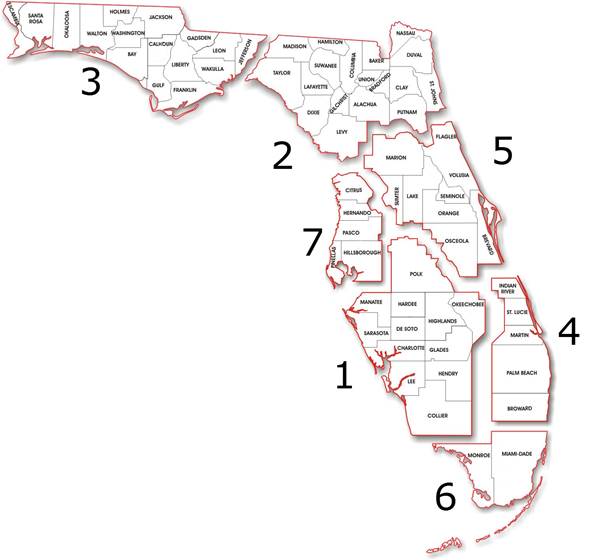

Florida's Turnpike Enterprise (FTE) Regional ITS Architecture (RITSA) is a roadmap for transportation systems integration for FTE ITS services in Florida over a 10-year time horizon. The FTE ITS Architecture is actually statewide in scope covering all the FDOT District regions except District 3. This architecture has been developed and maintained through a cooperative effort by the state's transportation agencies. The FTE RITSA complies with the FHWA Rule 940 requirements, as well as the FTA policy directives, for ITS Architectures. The FTE RITSA was converted to be compatible with the latest version of the Architecture Reference for Cooperative and Intelligent Transportation (ARC-IT) Version 9.3 which makes available all of the ARC-IT content for use in updates to the FTE RITSA. The FTE RITSA Conversion Report showing the results of the conversion to vVersion 9.3 and the converted FTE RITSA database are available under the Resource tab.
Change requests received for the FTE RITSA during the latest Architecture Maintenance cycle will be incorporated in a future architecture update.
The Statewide and Regional ITS Architectures represent a shared vision of how each agencies' systems will work together in the future, sharing information and resources to provide a safer, more efficient, and more effective transportation system for travelers in the State of Florida.
The FTE RITSA functionally defines the interactions and information exchanges between the intelligent transportation systems operated and maintained by the various public and private sector organizations at the statewide level. The FTE RITSA includes existing systems as well as planned systems and services that are needed to deliver the transportation services to improve safety, mobility and efficiency across the state.
The geographic scope of the FTE RITSA is boundaries of the state of Florida including all FDOT Districts with the exception of FDOT District 3.
The FTE RITSA is adjacent to the Georgia Statewide ITS Architecture to the north and overlaps the Statewide ITS Architecture (SITSA) and all of the District Regional ITS Architectures with the exception of the District 3 RITSA. There are FTE transportation systems that interface with regional systems. The interfaces with these components are shown to relate the interdependencies of the systems in the delivery of toll related services at the regional level.
The needs, studies and plans of stakeholders in the FTE RITSA and the adjacent and overlapping architectures were considered when developing the content for the FTE RITSA and stakeholders' project definition and input.
The FTE RITSA is used by transportation agencies to define, and by transportation planners to plan, ITS projects that address transportation needs. The FTE RITSA provides a functional framework into which an ITS project is integrated. This framework is used as a reference from which a project is defined. Using the Regional Architecture Development for Intelligent Transportation (RAD-IT) software tool, an agency will choose the transportation services, identify the systems to be included, and then select the information exchanges to tailor the project to address the stakeholders' transportation needs.
The FTE RITSA, including the defined ITS projects, is used as a reference in transportation planning activities at all levels to coordinate and integrate ITS at the statewide level. Integration opportunities are considered by stakeholders as their projects are defined using the FTE RITSA content as a guide. The RITSA offers a broader picture that the stakeholders take into consideration when thinking of the project definition. The project definitions take into account other systems and services that may be germane to the project scope and future expansion. The projects are defined within the FTE RITSA domain and it is the projects where the integration opportunities are codified. The project definitions in the FTE RITSA are the first opportunity for integration considerations. Project development in further detail in systems engineering is another opportunity. The FTE RITSA is a primary source for those integration opportunities in both cases.
The Statewide and Regional ITS Architectures have a time horizon of ten years with particular focus on those transportation elements likely to be implemented in the next three years. The ITS architecture covers the broad spectrum of Intelligent Transportation Systems, including Traffic Management, Transit Management, Traveler Information, Maintenance and Construction, Emergency Management, and Archived Data Management over this time horizon. The architecture content supports the quickly emerging and evolving Connected and Automated Vehicle (CAV) environment. CAV presents greater integration and interoperability challenges and the need for institutional cooperation makes the ITS Architecture a valuable tool to discuss and plan these complex implementations.
The purpose of the ITS Architecture web site is to encourage use of the Florida Statewide and Regional ITS architectures, and to gather feedback so that it is used and continues to reflect the intelligent transportation system vision for the state and each district. The menu bar above provides access to the stakeholders, the transportation systems in the region (the "Inventory"), the transportation services that will be provided, transportation-related functions that are envisioned, the existing and planned interfaces in the region, and the "Projects" that are planned for ITS from Stakeholders.
The majority of this web site was generated directly from a Regional Architecture Development for Intelligent Transportation (RAD-IT) software database which defines the architecture for the FTE RITSA. The source database is also available for download under "Resources" in the menu bar above.